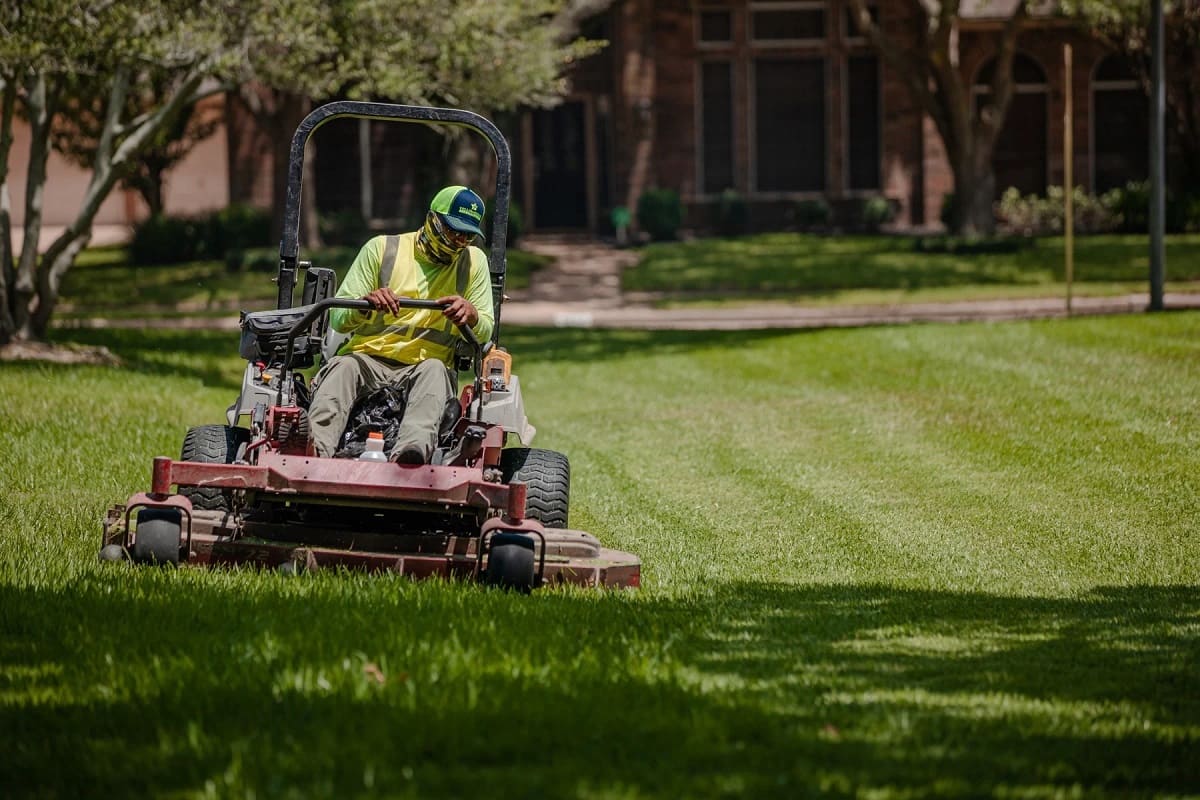Home>Garden Essentials>How To Get Landscaping Contracts


Garden Essentials
How To Get Landscaping Contracts
Modified: March 7, 2024
Learn how to land more garden landscaping contracts with our comprehensive guide. From bidding strategies to marketing tactics, we've got you covered.
(Many of the links in this article redirect to a specific reviewed product. Your purchase of these products through affiliate links helps to generate commission for Storables.com, at no extra cost. Learn more)
Introduction
Welcome to the exciting world of landscaping! If you have a passion for plants, design, and transforming outdoor spaces, then starting a landscaping business might be the perfect fit for you. As the demand for outdoor beautification continues to grow, there is ample opportunity for success in this industry.
However, navigating the landscaping industry can be challenging without a solid understanding of the market, effective marketing strategies, and the skills needed to secure contracts. That’s why in this article, we will provide you with a comprehensive guide on how to get landscaping contracts and elevate your business.
Before diving into the specifics, it’s essential to have a clear idea of what the landscaping industry entails. Landscaping involves creating and maintaining aesthetically pleasing outdoor spaces, which can include everything from planting flowers and trees, designing hardscapes, installing irrigation systems, and even building outdoor structures like patios and gazebos.
Landscaping businesses cater to both residential and commercial clients. Residential clients may hire landscapers to enhance the curb appeal of their homes, create outdoor living spaces, or transform their backyard into a tranquil oasis. Commercial clients, on the other hand, might require landscaping services for office complexes, retail spaces, parks, or hotels.
Now that we have a basic understanding of the landscaping industry, let’s explore the steps to take in order to secure landscaping contracts. From identifying your target market and developing a business plan to marketing your services and building professional relationships, we’ll cover it all.
So, grab your gardening gloves and let’s dive in, as we provide you with invaluable tips and strategies to help you succeed in the world of landscaping and secure those highly coveted contracts.
Key Takeaways:
- Understanding the landscaping industry, identifying your target market, and creating a solid business plan are crucial steps to securing landscaping contracts and building a successful business in the industry.
- Providing high-quality services, managing customer relationships effectively, and handling challenges with professionalism are essential for long-term growth and success in the landscaping business.
Read more: How To Find Landscape Design Contracts
Understanding the Landscaping Industry
Before you can successfully secure landscaping contracts, it’s crucial to have a deep understanding of the industry. This knowledge will not only help you position your business effectively but also enable you to provide top-notch services that meet the needs of your clients.
One of the key aspects of understanding the landscaping industry is staying up-to-date with the latest trends and techniques. Landscaping, like any other industry, evolves over time as new design concepts, plant varieties, and eco-friendly practices emerge. Keep yourself informed by attending industry conferences, workshops, and trade shows. Joining professional associations such as the National Association of Landscape Professionals (NALP) can also provide valuable networking opportunities and access to educational resources.
Another crucial component of understanding the landscaping industry is knowing your competition. Research existing landscaping businesses in your area to get a sense of the services they offer, their pricing structure, and their target market. This information will help you differentiate your business and identify gaps in the market that you can capitalize on. It’s also beneficial to research local regulations and permits required for landscaping projects.
Understanding the needs and preferences of your target market is paramount. Different clients have different expectations when it comes to landscaping services. For example, residential clients may prioritize aesthetics, privacy, and creating spaces for relaxation and entertainment. Commercial clients, on the other hand, may value functionality, low maintenance designs, and sustainable practices. By understanding the unique needs of your target market, you can tailor your services to exceed their expectations.
Additionally, it’s important to keep in mind seasonal fluctuations in the landscaping industry. Spring and summer tend to be the busiest seasons, as clients want their gardens to flourish and outdoor spaces to be ready for enjoyment. Winter, on the other hand, might be slower, but it presents opportunities for services like snow removal and seasonal maintenance. Understanding these seasonal trends will help you plan and optimize your business operations accordingly.
Lastly, having a solid understanding of the financial aspects of the landscaping industry is crucial. Pricing your services appropriately, tracking expenses, and managing cash flow are essential for the long-term success of your business. Consider factors such as labor costs, materials, equipment, overhead expenses, and the desired profit margin when determining your pricing structure.
By truly comprehending the landscaping industry, you’ll be equipped with the knowledge and insights needed to position your business for success. Now that we have a strong foundation, let’s move on to identifying your target market.
Determining Your Target Market
Identifying your target market is a critical step in getting landscaping contracts. By understanding who your ideal clients are, you can tailor your marketing efforts, services, and pricing to attract and retain them. Here are some key considerations to help you determine your target market:
1. Residential or Commercial: Decide whether you want to focus on residential clients, commercial clients, or both. Each segment has its own unique characteristics and requirements. Residential clients may be homeowners looking to enhance their personal spaces, while commercial clients can be businesses or organizations in need of landscaping services for their properties.
2. Geographic Area: Determine the specific geographic area in which you want to operate. Consider factors such as population density, income levels, and competition. Choosing a target area allows you to focus your marketing efforts and better understand the needs and preferences of the local community.
3. Demographics: Analyze the demographics of your target market. Consider factors such as age, income level, lifestyle, and household size. These insights can help you tailor your services and marketing messages to resonate with your intended audience.
4. Specializations: Consider specializing in a specific type of landscaping service or niche market. This could be anything from eco-friendly landscaping, water conservation, hardscaping, or specific plant varieties. Having a niche can help you stand out from the competition and attract clients who are specifically looking for your unique expertise.
5. Competition Analysis: Research your competition within your target market. Identify what services they offer, how they position themselves, and what sets them apart. This research will help you differentiate your business and find your unique selling points.
6. Customer Preferences: Understand the needs and preferences of your target market. Conduct surveys, interviews, or focus groups to gather insights about what clients value in landscaping services. This will enable you to tailor your services and marketing messages to align with their preferences.
Remember, your target market may evolve over time as your business grows and you gain a better understanding of your clients’ needs. Continuously track your performance, collect feedback, and adapt your strategies accordingly.
Once you have determined your target market, you can move on to creating a business plan to guide your overall strategy. Let’s explore the next step in our journey to getting landscaping contracts.
Creating a Business Plan
A well-crafted business plan is essential for the success of your landscaping business. It serves as a roadmap that outlines your goals, strategies, and financial projections. Here are the key components to include in your business plan:
1. Executive Summary: This section provides an overview of your business, including its mission, vision, and core values. It should also highlight your unique selling points and the competitive advantage you offer.
2. Company Description: Describe your landscaping business in detail. Include information about the services you offer, your target market, and your qualifications and experience in the industry. Be sure to communicate your business’s value proposition and why clients should choose you over competitors.
3. Market Analysis: Conduct a thorough analysis of the landscaping industry and your target market. Include information about industry trends, customer preferences, and the competitive landscape. Identify opportunities and challenges that exist in the market and explain how you plan to capitalize on the former and mitigate the latter.
4. Organizational Structure: Outline the organizational structure of your business, including key roles and responsibilities. Specify whether you will be a sole proprietorship, partnership, or corporation. Additionally, mention any external professionals or consultants you plan to work with, such as accountants, lawyers, or landscapers.
5. Marketing and Sales Strategy: Describe how you plan to market your landscaping services and attract clients. This should include your branding strategy, online presence, traditional advertising methods, and any unique promotional campaigns or strategic partnerships you plan to pursue. Outline your sales process and how you will convert leads into paying clients.
6. Financial Projections: Present a detailed financial forecast for the upcoming years. Include projected revenue, expenses, and profitability. If you are seeking funding, include information about your startup costs, funding requirements, and potential sources of financing.
7. Operations and Management: Detail your day-to-day operations, including equipment and inventory requirements, supplier relationships, and project management processes. Describe how you plan to manage and train your staff, ensuring quality workmanship and customer satisfaction.
8. Risk Analysis and Contingency Plans: Identify potential risks and challenges that may arise in the landscaping industry. Explain how you plan to mitigate these risks and have contingency plans in place to address unforeseen circumstances. This demonstrates to potential investors or lenders that you have thought through potential challenges and have strategies to mitigate them.
Remember, your business plan should be a living document that evolves as your business grows. Regularly review and update it to reflect changes in the market, customer preferences, and your business’s performance.
Creating a strong business plan will not only help you clarify your goals and strategies but also make you more attractive to potential investors and lenders. Now that you have a solid plan in place, it’s time to start building your portfolio.
Building Your Portfolio
Building a strong portfolio is crucial for showcasing your skills and expertise as a landscaper. A well-curated portfolio not only demonstrates your capabilities but also helps you establish credibility and attract potential clients. Here are some key steps to building an impressive landscaping portfolio:
1. Document Your Work: Start by documenting your past projects. Take high-quality photographs or video footage of completed landscaping projects, highlighting different aspects such as before-and-after transformations, unique design elements, and attention to detail. These visual representations will be the centerpiece of your portfolio and provide tangible evidence of your skills.
2. Show Diversity: Include a variety of projects in your portfolio to showcase your range of capabilities. This could include examples of residential gardens, commercial landscapes, hardscaping projects, and any other specialized services you offer. Displaying a diverse portfolio will demonstrate your adaptability to different client needs and increase your chances of appealing to a wider range of potential clients.
3. Highlight Your Expertise: Emphasize your areas of expertise within your portfolio. If you specialize in a particular style of landscaping, such as modern or sustainable, make sure to showcase projects that highlight these elements. Additionally, if you have received any certifications or awards, be sure to include them as well.
4. Provide Project Details: Accompany each portfolio piece with a brief description of the project. Include details such as the client’s requirements, your approach to the design, any challenges faced, and how you overcame them. This information will give potential clients insight into your thought process and problem-solving abilities.
5. Before and After: Whenever possible, include before-and-after images of your projects. This allows potential clients to see the transformative impact of your work and better visualize what you can achieve for them. The dramatic contrast will help showcase your ability to create stunning outdoor spaces.
6. Client Testimonials: Incorporate client testimonials or reviews in your portfolio. Positive feedback from satisfied clients adds credibility to your work and reinforces your professionalism and reliability. Collect testimonials from previous clients and display them alongside the respective project in your portfolio.
7. Online Presence: Create an online platform, such as a website or social media profiles, to showcase your portfolio. This will maximize your reach and accessibility, allowing potential clients to view your work from anywhere at any time. Make sure your online presence is visually appealing, easy to navigate, and optimized for search engines to improve your visibility in online searches.
Remember, your portfolio is a living entity that evolves as you complete new projects. Regularly update it with fresh content, remove outdated projects, and refine the presentation to reflect the growth and development of your skills and style.
Building a captivating portfolio takes time and dedication, but it is an essential investment in the success of your landscaping business. With a strong portfolio in place, you’ll be well-positioned to impress potential clients and secure those sought-after landscaping contracts. Now, let’s move on to developing an effective marketing strategy to promote your services.
Read more: How To Write Up A Landscaping Contract
Developing a Marketing Strategy
An effective marketing strategy is crucial for attracting clients and standing out in the competitive landscaping industry. By developing a clear and targeted marketing plan, you can increase your visibility, generate leads, and ultimately secure more landscaping contracts. Here are some key steps to developing a successful marketing strategy:
1. Define Your Brand: Start by defining your brand identity. Determine what sets you apart from competitors and establish a unique value proposition. Think about your mission, core values, and the key messages you want to communicate to potential clients. Your brand should resonate with your target market and convey the essence of your landscaping business.
2. Identify Your Target Audience: Clearly define your target audience based on demographics, preferences, and needs. Understand their pain points and motivations, and tailor your marketing messages accordingly. By targeting the right audience, your marketing efforts will be focused and more likely to resonate with potential clients.
3. Create a Professional Website: Establish a professional and visually appealing website that showcases your portfolio, services, and contact information. Make sure your website is mobile-friendly, easy to navigate, and optimized for search engines. Regularly update your website with fresh and engaging content, such as blog posts or case studies, to improve your search engine rankings and attract organic traffic.
4. Leverage Social Media: Use social media platforms to increase your online presence and engage with your target audience. Identify the platforms where your ideal clients are most active and create compelling content, including images and videos, that showcases your work, expertise, and industry knowledge. Engage with followers by responding to comments, sharing useful tips, and participating in relevant conversations.
5. Online Advertising: Consider utilizing online advertising platforms like Google Ads or social media ads to expand your reach and drive targeted traffic to your website. Carefully select keywords and demographics to ensure your ads are seen by potential clients who are actively searching for landscaping services.
6. Local SEO: Optimize your online presence for local search engine optimization. This includes registering your business with online directories, optimizing your website and content with location-specific keywords, and encouraging clients to leave positive reviews. Consistency in your business information across all platforms is crucial for local SEO.
7. Referral Program: Implement a referral program to incentivize your existing clients to refer your services to their friends, family, and colleagues. Offer discounts, rewards, or exclusive perks to clients who refer new business to you. Word-of-mouth recommendations can be a powerful marketing tool that can lead to a steady stream of new leads.
8. Networking and Partnerships: Attend industry events, join local business associations, and connect with complementary professionals such as real estate agents or interior designers. Building relationships with professionals who cater to similar clients can lead to partnerships and referrals.
9. Traditional Marketing: Don’t overlook traditional marketing methods such as distributing flyers, placing ads in local newspapers or magazines, sponsoring community events, or participating in local trade shows. These offline strategies can help you reach potential clients who might not be actively searching online for landscaping services.
Remember, consistency is key in marketing. Develop a marketing plan that encompasses both online and offline channels, and regularly measure and track the effectiveness of your marketing efforts. Adapt your strategies based on what works best for your target audience and the specific needs of your landscaping business.
With a well-executed marketing strategy, you’ll increase your visibility, attract qualified leads, and ultimately secure more landscaping contracts. Now, let’s dive into the importance of networking and building professional relationships in the landscaping industry.
Networking and Building Professional Relationships
In the landscaping industry, networking and building strong professional relationships are invaluable for securing contracts and growing your business. By establishing connections with fellow professionals, industry experts, and potential clients, you increase your visibility, gain valuable insights, and create opportunities for collaboration. Here are some key strategies to help you effectively network and build professional relationships:
1. Attend Industry Events: Make it a priority to attend industry events such as conferences, trade shows, and seminars. These gatherings provide valuable opportunities to connect with other professionals in the field, stay updated on industry trends, and learn from experts’ experiences. Prepare your elevator pitch and bring business cards to share with potential contacts.
2. Join Professional Associations: Consider joining professional associations such as the National Association of Landscape Professionals (NALP) or local landscaping organizations. These associations offer networking events, educational resources, and access to a community of like-minded professionals. Engage in discussions, participate in forums, and take advantage of any mentorship or certification programs available.
3. Collaborate with Complementary Professionals: Build relationships with professionals in related industries who cater to similar clients. This could include architects, builders, interior designers, or property managers. By establishing mutually beneficial partnerships, you can refer clients to each other and potentially collaborate on joint projects, expanding your reach and offering comprehensive services to clients.
4. Participate in Local Community Activities: Get involved in local community events or sponsor local projects. This not only helps raise awareness of your business but also demonstrates your commitment to the community. Participating in community activities also provides opportunities to network with potential clients, business owners, and influential individuals who might refer your services in the future.
5. Nurture Existing Client Relationships: Building and maintaining strong relationships with your existing clients is just as important as networking with new contacts. Deliver exceptional customer service, exceed expectations, and follow up with clients after completing projects. Foster long-term relationships by checking in periodically, offering seasonal maintenance services, and providing helpful tips and advice to ensure their outdoor spaces continue to thrive.
6. Utilize Online Networking Platforms: Harness the power of online networking platforms such as LinkedIn or industry-specific forums to connect with professionals, share knowledge, and initiate collaborations. Engage in discussions, contribute valuable content, and reach out to potential contacts within your target market.
7. Ask for Referrals: Don’t be afraid to ask satisfied clients for referrals. A happy client is likely to recommend your services to friends, family, or colleagues in need of landscaping. Offer incentives or discounts for successful referrals as a way to encourage your clients to refer your business to others.
Remember, networking and building professional relationships is an ongoing process. Continuously devote time and effort to expanding your network, nurturing existing relationships, and exploring new opportunities for collaboration. Building a strong network of professionals who know, trust, and refer your services can lead to a steady stream of contracts and long-term business growth.
Now that you understand the importance of networking, it’s time to explore the next crucial step in securing landscaping contracts: bidding and pricing your services.
Bidding and Pricing Your Services
Bidding and pricing your landscaping services accurately and competitively is essential for securing contracts and maximizing profitability. A well-thought-out approach to estimating costs and determining pricing will help you attract clients while ensuring your business remains financially sustainable. Consider these key factors when bidding and pricing your services:
1. Estimate Project Costs: Begin by thoroughly assessing the scope of each project and estimating the associated costs. Consider factors such as labor, materials, equipment rentals, and any subcontractors you may need to hire. Accurately estimating project costs will provide a foundation for determining your pricing strategy.
2. Factor in Overhead Expenses: Account for overhead expenses such as office rent, insurance, licensing fees, marketing costs, and equipment maintenance. These indirect costs are essential for the smooth operation of your business and should be factored into your pricing to ensure accountability and profitability.
3. Time and Labor: Calculate the time and labor required to complete each project. Consider the complexity of the design, the size of the area to be landscaped, and the number of crew members needed. Your labor costs should be proportionate to the time and effort required for the job.
4. Research Industry Standards: Research industry standards for pricing in your area. Look at the rates charged by your competitors and consider the quality of services they provide. While it’s important to remain competitive, also ensure that your pricing enables you to cover your costs and generate a profit.
5. Value-Based Pricing: Consider the value and benefits that your landscaping services provide to clients. Determine the unique selling points and added value that sets your business apart. When pricing your services, factor in the expertise, quality craftsmanship, and personalized attention you offer, as this justifies a higher price point compared to competitors.
6. Seasonal Considerations: Take into account seasonal factors that might impact your pricing. For example, during peak seasons when demand is high, you may be able to charge a premium for your services. Conversely, during slower seasons, you may need to adjust your pricing to remain competitive and attract clients.
7. Maintaining Profitability: While it’s important to offer competitive prices, it’s equally crucial to ensure your business remains profitable. Regularly review your pricing strategy and assess whether it aligns with your business goals and financial targets. Conduct a profitability analysis to monitor and adjust your pricing as needed.
8. Provide Detailed Quotes: Present potential clients with detailed and transparent quotes that outline the scope of work, itemized costs, and any additional services or options available. Clear and comprehensive quotes help clients understand the value they will receive and reduce the likelihood of misunderstandings or disputes down the line.
9. Competitive Advantages: Highlight your unique competitive advantages when presenting your quote to potential clients. Emphasize the qualifications, experience, and testimonials that set your business apart from competitors. By showcasing your expertise and professionalism, you can justify your pricing and instill confidence in prospective clients.
Remember, pricing is not a one-size-fits-all approach. Each project will have its own unique requirements and considerations. Continuously evaluate and refine your pricing strategy to ensure it aligns with your business goals, market demands, and profitability objectives.
With a well-calculated bidding and pricing strategy in place, you’ll be able to submit competitive quotes, win contracts, and establish your business as a trusted and reliable landscaping service provider. Now, let’s discuss the importance of writing effective proposals to impress potential clients.
Tip: Network with local real estate agents, property managers, and homeowners’ associations to increase your chances of getting landscaping contracts. Building relationships with these key players can lead to valuable referrals and new business opportunities.
Writing Effective Proposals
Writing an effective proposal is crucial for impressing potential clients and winning landscaping contracts. A well-crafted proposal demonstrates your professionalism, showcases your expertise, and outlines a comprehensive plan to meet the client’s needs. Here are some key points to consider when writing effective proposals:
1. Understand the Client’s Requirements: Before drafting your proposal, thoroughly understand the client’s needs and objectives. Ask clarifying questions and listen attentively to their expectations. Tailor your proposal to address their specific concerns and demonstrate that you understand their unique requirements.
2. Introduction and Executive Summary: Start your proposal with a compelling introduction that grabs the client’s attention. Include an executive summary that summarizes the key points of your proposal, highlighting the benefits they will receive by choosing your services.
3. Clearly Define Scope of Work: Clearly outline the scope of work, detailing each service you will provide. Break down the project into specific tasks and deliverables, providing a timeline for completion. Set realistic expectations for both parties and address any potential limitations or constraints upfront.
4. Showcase your Expertise: Describe your qualifications, experience, and previous projects relevant to the client’s needs. Highlight any special certifications or training that sets you apart from competitors. Share testimonials or case studies that demonstrate your ability to deliver exceptional results.
5. Provide a Detailed Project Plan: Present a detailed plan that outlines each step of the project, including design concepts, materials to be used, and equipment required. Explain your methodology and the expertise you will bring to the project. Emphasize how your approach will address the client’s specific goals and preferences.
6. Financial Considerations: Clearly outline the pricing structure and payment terms. Break down the costs associated with each service and include any optional add-ons or upgrades. Specify any payment milestones or deadlines to provide clarity and transparency.
7. Address Sustainability and Environmental Considerations: If applicable, highlight your commitment to environmentally friendly practices and sustainable landscaping solutions. Discuss how you integrate eco-friendly techniques, conserve water, or promote biodiversity in your designs.
8. Offer Additional Support: Provide details about ongoing maintenance or post-construction support that you offer. Assure the client that you will be available for any inquiries, adjustments, or additional services they may require after the project is completed.
9. Professional Presentation: Pay attention to the layout, formatting, and grammar of your proposal. Use professional language and include visual elements like images, sketches, or renders to visually enhance your proposal and demonstrate your design ideas.
10. Follow-Up and Timelines: Clearly state the deadline for the client to review and accept the proposal. Set expectations for when you will follow up with the client to discuss any questions or concerns they may have.
Remember, a well-written proposal should be persuasive, comprehensive, and tailored to the client’s needs. It should clearly communicate the value you will provide and instill confidence in your ability to deliver exceptional landscaping services.
By following these tips and customizing your proposals for each client, you can impress potential clients, stand out from the competition, and increase your chances of winning landscaping contracts. Now, let’s discuss the crucial aspect of securing and negotiating contracts.
Read more: How To Get Contracts For Construction
Securing and Negotiating Contracts
Securing and negotiating contracts is a critical step in the success of your landscaping business. The ability to effectively communicate, build trust, and negotiate terms that are mutually beneficial is key to securing profitable contracts. Here are some essential tips to help you secure and negotiate contracts:
1. Understand Client Needs: Begin by thoroughly understanding the client’s needs and expectations. Listen attentively and ask probing questions to gain a deeper understanding of their specific requirements. This will enable you to tailor your proposal and negotiate terms that align with their vision.
2. Offer Competitive Pricing: When presenting your pricing, ensure it is competitive yet profitable for your business. Consider the scope of work, project complexity, and market rates. Demonstrate the value and benefits your services will provide, justifying your pricing to clients.
3. Be Clear and Comprehensive: Clearly articulate the scope of the work, timeline, and deliverables within the contract. Include any specific terms or conditions that both parties need to agree upon. A well-defined contract reduces the risk of misunderstandings and disputes down the line.
4. Clearly Define Responsibilities: Clearly outline the responsibilities of both parties in the contract. Detail what services you will provide and any client obligations, such as providing access to the property or obtaining necessary permits. This clarity ensures that expectations are aligned and minimizes potential disagreements.
5. Address Payment Terms: Clearly state payment terms, including the amount, schedule, and method of payment. Specify any upfront deposits or progress payment milestones. By clearly communicating payment expectations, you can avoid payment delays and ensure a smooth financial transaction.
6. Establish Change Order Procedures: Include a clause in the contract that outlines how any changes to the original scope of work will be addressed. Detail the process for requesting and approving changes, as well as how additional costs or adjustments will be handled. This provides a mechanism for managing project changes without disrupting the contract.
7. Communication and Documentation: Maintain open and frequent communication with the client throughout the contract negotiation process. Respond promptly to inquiries and provide any requested documentation or clarification. Clear communication builds trust and confidence with the client.
8. Be Flexible and Open to Negotiation: Approach contract negotiations with a mindset of collaboration. Be open to discussions and compromises that benefit both parties. Finding a middle ground that meets the client’s needs while protecting your business interests is key to successful contract negotiation.
9. Seek Legal Advice: If necessary or for more complex contracts, consult with a legal professional to ensure the contract is legally sound and protects your interests. Legal advice can help clarify any ambiguous terms, minimize risks, and provide valuable guidance throughout the negotiation process.
10. Review and Finalize: Review the contract together with the client, addressing any outstanding questions or concerns. Make any necessary amendments as agreed upon during negotiations. Once both parties are satisfied, ensure all parties sign and receive a copy of the final contract.
Remember, securing and negotiating contracts requires effective communication, flexibility, and a focus on mutually beneficial terms. By establishing a strong rapport with clients, demonstrating the value of your services, and finding common ground, you can successfully secure profitable contracts for your landscaping business.
Now that you have secured the contracts, it’s time to deliver quality services and build long-lasting customer relationships. Let’s explore the importance of providing exceptional landscaping services.
Providing Quality Services
Providing quality services is the cornerstone of a successful landscaping business. It’s not only about creating beautiful outdoor spaces but also delivering exceptional customer experiences. By consistently exceeding client expectations and delivering outstanding workmanship, you can build a strong reputation and secure repeat business. Here are some essential tips for providing high-quality landscaping services:
1. Attention to Detail: Pay meticulous attention to the details of every project. Ensure that every element is executed with precision, from the placement of plants and materials to the finishing touches. Strive for perfection and take pride in delivering flawless results.
2. Skilled Workforce: Employ and train skilled professionals who have a deep understanding of landscaping techniques, design principles, and horticulture. Continuously invest in your team’s development to ensure their expertise remains up to date.
3. Quality Materials: Use high-quality materials and plants for your projects. Select durable and sustainable options that will withstand the test of time and ensure the longevity and success of your installations. Consider factors such as climate compatibility and maintenance requirements when choosing materials.
4. Timely Project Completion: Meet your project deadlines consistently. Establish clear timelines and manage the progress of each project efficiently. Communicate any delays or challenges to clients promptly and provide reassurance regarding the steps being taken to resolve them.
5. Effective Communication: Maintain open and transparent communication with your clients throughout the entire project. Regularly update them on progress, answer their inquiries promptly, and keep them informed about any necessary adjustments or unforeseen circumstances. Clear and timely communication fosters trust and builds long-term relationships.
6. Professionalism and Reliability: Be professional in all aspects of your work. Arrive on time, follow through on commitments, and conduct yourself with integrity. Demonstrate respect for your clients’ properties by keeping the work area clean and minimizing disruptions to their daily lives.
7. Customization and Personalization: Tailor your services to meet the unique needs and preferences of each client. Take the time to understand their vision and incorporate their ideas into the design. Offer suggestions and creative solutions that enhance their outdoor spaces while reflecting their personal style.
8. Ongoing Maintenance and Support: Provide post-construction maintenance and support services to ensure your landscapes continue to thrive. Educate clients on proper care and maintenance practices, and offer recurring maintenance packages to keep their outdoor spaces looking their best. This commitment to ongoing support reinforces your dedication to client satisfaction.
9. Continual Improvement: Strive for continual improvement by seeking feedback from clients and implementing their suggestions. Regularly evaluate your processes, learn from past projects, and implement best practices. Stay up to date with industry trends, innovative techniques, and emerging technologies to enhance the quality and efficiency of your services.
10. Exceed Expectations: Go the extra mile to exceed client expectations. Surprise them with small touches, such as complimentary plantings or unique design elements. Delivering beyond what was promised creates unforgettable experiences and generates positive word-of-mouth referrals.
By consistently providing high-quality services, you can cultivate satisfied clients who are more likely to become loyal supporters of your business. Their positive experiences will lead to valuable testimonials, referrals, and an excellent reputation within the landscaping industry.
Now, let’s explore the importance of managing customer relationships and handling challenges effectively within your landscaping business.
Managing Customer Relationships
Effective customer relationship management is crucial for the success of your landscaping business. Building strong relationships with your clients fosters loyalty, generates repeat business, and leads to valuable word-of-mouth referrals. By prioritizing customer satisfaction and creating positive experiences, you can establish yourself as a trusted and reliable landscaping service provider. Here are some important tips for managing customer relationships:
1. Clear Communication: Maintain open and transparent communication with your clients throughout their entire landscaping journey. Actively listen to their needs, concerns, and feedback. Keep them informed about project progress, timelines, and any necessary adjustments. Respond promptly to inquiries and demonstrate that their satisfaction is your top priority.
2. Personalized Approach: Treat each client as an individual with unique needs and preferences. Take the time to understand their vision and tailor your services accordingly. Offer personalized recommendations and creative solutions that align with their goals and reflect their personal style.
3. Regular Site Visits: Conduct regular site visits to assess the condition of completed projects and address any maintenance needs. Proactively identify and resolve issues before they become major concerns. This hands-on approach shows your commitment to quality and reinforces your dedication to customer satisfaction.
4. Prompt Issue Resolution: Address any problems or concerns that may arise promptly and professionally. Listen attentively, empathize with the client’s perspective, and provide a reasonable solution. Resolve issues in a timely manner to minimize disruptions and ensure that clients feel valued and heard.
5. Exceed Expectations: Strive to exceed client expectations at every opportunity. Surprise and delight them with small gestures, such as additional plantings, complimentary services, or unexpected upgrades. Going above and beyond creates memorable experiences and fosters a strong sense of loyalty.
6. Feedback and Reviews: Regularly seek feedback from clients on their experience with your services. Encourage them to leave reviews or provide testimonials that highlight their positive experiences. Actively respond to reviews, whether positive or negative, to show that you value client feedback and are committed to continuous improvement.
7. Customer Appreciation: Show appreciation for your clients by expressing gratitude for their business. Consider sending personalized thank-you notes or small tokens of appreciation. Remembering important milestones, such as project anniversaries or birthdays, goes a long way in building lasting relationships.
8. Ongoing Support: Offer ongoing support to clients even after the completion of their projects. Provide guidance on maintenance practices, seasonal care, and any additional services they may require. Regularly follow up to ensure their satisfaction and address any new landscaping needs that may arise.
9. Professionalism and Trust: Maintain a high level of professionalism and trustworthiness in all interactions with your clients. Honor your commitments, deliver on your promises, and conduct yourself with integrity. This level of professionalism builds trust and cultivates strong, long-term relationships.
10. Continual Improvement: Continually strive to improve your services based on client feedback and changing industry trends. Stay updated with new techniques, technologies, and design trends to offer the best possible solutions to your clients. Demonstrate a commitment to growth and adaptability in response to evolving client needs.
By effectively managing customer relationships, you can create positive experiences that lead to loyal clients who will recommend your services to others. These satisfied clients become valuable brand advocates and contribute to the long-term success and growth of your landscaping business.
Now, let’s explore the importance of handling challenges and difficult customers in a professional and effective manner.
Handling Challenges and Difficult Customers
While providing high-quality landscaping services, it’s inevitable that you may encounter challenges and difficult customers from time to time. How you handle these situations can make a significant difference in maintaining client satisfaction and the reputation of your business. Here are some essential strategies for effectively managing challenges and difficult customers:
1. Stay Calm and Professional: Remain calm and composed, even in challenging situations. It’s important to maintain a professional demeanor and refrain from reacting emotionally. Responding with empathy and professionalism will de-escalate tense situations and facilitate productive resolutions.
2. Active Listening: Listen attentively to your customer’s concerns and frustrations. Let them express their viewpoints without interruption. Show genuine empathy and understanding, acknowledging their feelings and frustrations. Active listening demonstrates that you value their perspective and are committed to addressing their issues.
3. Maintain Clear Communication: Be proactive in maintaining clear and transparent communication during challenging situations. Keep the customer informed about the steps being taken to resolve the issue, the expected timeline, and any potential solutions. Regular updates help manage expectations and instill confidence in your commitment to finding a resolution.
4. Offer Solution-Oriented Approach: Work collaboratively with the customer to find a solution that meets their needs. Propose alternatives and options that address their concerns while remaining within the realm of what is feasible for your business. Be flexible and willing to negotiate, finding a mutually satisfactory resolution whenever possible.
5. Focus on Customer Satisfaction: Prioritize customer satisfaction by actively seeking ways to make things right. Whether it’s revisiting a problematic aspect of a project, offering additional services as a gesture of goodwill, or providing compensation if appropriate, prioritizing customer satisfaction can help salvage the relationship and maintain their trust.
6. Document Interactions: Keep a record of all interactions with difficult customers, including emails, phone calls, and meetings. Documenting these interactions can serve as a reference and provide protection in case disputes arise in the future. It also helps maintain a history of the process taken to resolve the issue.
7. Involve Higher Management if Necessary: If you are unable to resolve the issue directly, involve higher management or seek guidance from a senior team member. Their experience and perspective may offer insights or alternative approaches that can help find a resolution.
8. Learn and Improve: Embrace challenges as learning opportunities. Reflect on each situation and identify areas where you can improve your processes, communication, or problem-solving techniques. Continuous improvement allows you to better handle future challenges and strengthen your overall customer service approach.
9. Know When to Let Go: In some cases, despite your best efforts, it may not be possible to find a resolution that satisfies a difficult customer. Recognize when it is necessary to end the relationship respectfully. Continuously investing excessive time and energy into a difficult customer may impact your ability to serve other clients effectively.
10. Maintain Professional Boundaries: While it’s essential to address customer concerns, it’s equally important to establish and maintain professional boundaries. Ensure that communication remains respectful and focused on resolving the issue at hand. Set realistic expectations and establish clear guidelines for appropriate behavior.
Handling challenges and difficult customers is an opportunity to showcase your professionalism and commitment to excellent customer service. By approaching these situations with empathy, clear communication, and a solution-oriented mindset, you can not only resolve conflicts but also potentially turn difficult customers into satisfied, loyal advocates for your business.
Now that we’ve explored handling challenges, let’s discuss the importance of scaling your landscaping business for long-term growth.
Scaling Your Landscaping Business
Scaling your landscaping business is an exciting milestone that allows you to expand your operations, increase revenue, and take your business to the next level. However, scaling requires careful planning, strategic decision-making, and a focus on sustainable growth. Here are some essential tips to help you scale your landscaping business effectively:
1. Assess and Improve Processes: Before scaling your business, streamline and optimize your existing processes. Evaluate your workflows, identify inefficiencies, and implement improvements. By enhancing your operations, you can increase productivity, reduce costs, and lay a solid foundation for future growth.
2. Hire and Train a Reliable Team: As your business grows, it becomes essential to hire and train a reliable team. Invest in recruiting skilled professionals who align with your brand values and can deliver high-quality workmanship. Implement a comprehensive training program to ensure consistency in service delivery and maintain your standards as you expand.
3. Delegate and Empower: Effective delegation is crucial for scaling your business. Trust your team members and empower them to take on more responsibility. Delegate tasks that are outside your expertise or can be handled more efficiently by others. This frees up your time to focus on strategic planning, business development, and overseeing operations.
4. Leverage Technology: Embrace technology to streamline operations and enhance efficiency. Implement software for project management, scheduling, invoicing, and customer relationship management. Utilize online platforms and social media channels to market your services, generate leads, and reach a broader audience. Technology can help you scale your business by automating processes and improving overall productivity.
5. Expand Service Offerings: Consider expanding your service offerings to meet the evolving needs of your clients. Offer additional services such as maintenance packages, seasonal cleanup, irrigation system installations, or landscape design. This diversification can attract new clients while providing additional revenue streams.
6. Develop Strategic Partnerships: Collaborate with complementary businesses to expand your reach and offer comprehensive solutions to your clients. Forge partnerships with architects, builders, interior designers, or property developers. This allows you to tap into their customer base and create referral networks that support mutual growth.
7. Develop a Brand Identity: As you scale, it’s vital to develop a strong brand identity that differentiates you from competitors. Invest in branding efforts, including a memorable logo, website, and marketing materials. Consistently deliver exceptional service and cultivate a positive reputation, which will help you attract new clients and stand out in the market.
8. Monitor Key Performance Metrics: Continuously monitor key performance indicators (KPIs) to track the progress and success of your business. These may include revenue growth, client retention rates, profit margins, customer satisfaction scores, and project timelines. Analyzing these metrics helps you make data-driven decisions and course corrections as you scale.
9. Secure Financing: Scaling often requires additional resources and capital. Explore financing options such as small business loans, lines of credit, or partnerships with investors. Carefully assess the financial implications and develop a realistic plan for managing your cash flow to support your scaling efforts.
10. Stay Customer-Centric: Throughout the process of scaling your business, prioritize customer satisfaction and maintain the high level of service that has helped you grow. Nurture existing client relationships, continue to exceed their expectations, and actively seek feedback for continuous improvement. Satisfied customers will become loyal advocates, referring your services and contributing to your overall growth.
Scaling your landscaping business is an exciting but complex endeavor. By implementing these strategies, continuously adapting to market demands, and remaining customer-centric, you can effectively scale your business, increase profitability, and create a strong foundation for long-term success.
As we conclude this guide, we hope that the insights and tips provided have equipped you with the knowledge and confidence to navigate the landscaping industry and secure valuable contracts. Remember, success in the landscaping business requires a combination of expertise, passion, creativity, and dedication to delivering exceptional experiences to your clients.
Best of luck on your journey to building a thriving landscaping business!
Conclusion
Congratulations on completing this comprehensive guide to securing landscaping contracts and building a successful business. We have covered a wide range of topics, from understanding the landscaping industry and determining your target market to developing a marketing strategy, networking, bidding and pricing your services, providing quality work, managing customer relationships, handling challenges, and scaling your business.
Throughout this journey, you have learned about the importance of staying knowledgeable about industry trends, effectively marketing your services, and building strong professional relationships. You have also gained insight into the significance of providing high-quality workmanship, managing customer relationships, and handling challenging situations with professionalism and empathy.
Remember, success in the landscaping industry requires a combination of technical expertise, creativity, effective communication, and a customer-centric approach. By continuously honing your skills, staying up-to-date with industry advancements, and delivering exceptional service, you can establish yourself as a trusted and sought-after landscaping service provider.
As you embark on your journey to secure landscaping contracts, adapt to market demands, and grow your business, always keep the needs and preferences of your clients at the forefront. Dedicating yourself to exceeding their expectations, providing innovative solutions, and building strong relationships will be the foundation of your success.
Be open to learning, embrace challenges as growth opportunities, and continually strive for improvement. Continuously adapt and refine your strategies to stay ahead in the competitive landscaping industry. Remember that success is a result of hard work, perseverance, and a commitment to delivering value to your clients.
We hope that this guide has provided you with valuable insights, practical tips, and inspiration to take your landscaping business to new heights. As you embark on your journey, stay passionate, stay dedicated, and continue to enhance your skills and knowledge to create stunning outdoor spaces that bring joy and beauty to your clients’ lives.
Best of luck on your exciting and rewarding adventure in the world of landscaping! Your expertise and dedication will surely leave a lasting impact on the outdoor spaces you create and the clients you serve.
Frequently Asked Questions about How To Get Landscaping Contracts
Was this page helpful?
At Storables.com, we guarantee accurate and reliable information. Our content, validated by Expert Board Contributors, is crafted following stringent Editorial Policies. We're committed to providing you with well-researched, expert-backed insights for all your informational needs.













0 thoughts on “How To Get Landscaping Contracts”